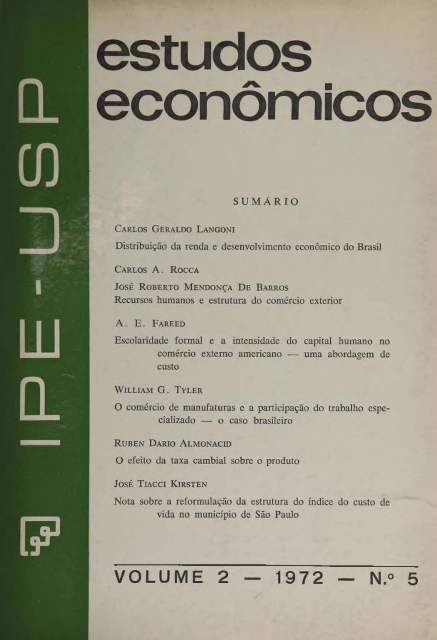Escolaridade formal e a intensidade do capital humano no comércio exterior americano - uma abordagem de custo
DOI:
https://doi.org/10.11606/1980-5357253aefResumo
Diversos autores tentaram discutir o problema do capital humano no comércio exterior americano: alguns em termos muito amplos, como os índices ocupacionais de Leontief1; outros com mais detalhes, como os índices de qualificação de Keesing2 e os coeficientes das taxas de retorno capitalizadas de Kenen-Yudin3. Em adição a estas contribuições, o presente estudo utiliza uma aproximação mais desagregadae, a fim de dar mais consistência com a literatura existentesobre a intensidade do capital convencional no comércio exterior, concebe o estoque de capital humano em termos dos custos, em dólares, dos fluxos de investimentos acumulados que o criaram, ao invés dos valores capitalizados das suas taxas de retorno.
Downloads
Referências
G. Becker, Human Capital, New York: Columbia University Press, para o Escritório Nacional de Pesquisas Econômicas, (NBER ), 1964 “Underinvestment in College Education” American Economic Review , Papers and Proceedings, maio I960, SO, 346-54.
R . Blitz, “The Nation’s Educational Outlay” Economics of Higher Education, Washington, D . C .: Government Printing Office, 1962.
E . Dennison e A . Slater, “Incomes in Selected Professions” Parte 4, “ Medical Service”, Survey of Current Business, out. 1943, 23, 16-20:
A . Fareed, “ Formal Schooling and the Human Capital Intensity of American Foreign Tm de — a Cost Approach” dissertação para doutoramento ainda não publicada, Vanderbilt University, 1970.
P Kenen e E. Yudin, Skills, Human Capital, and V. S. Foreign Trade, New York, Columbia University International Economics Workshop, 1965.
D . Keesing, “ Labor Skills and International Trade: Evaluating Many Trade Flows with a Single Device” Review of Economics and Statistics, Agosto 196S, 47, 287-94.
W. Leontief, “Domestic Production and Foreign Trade: The American Capital Position Re-examined” . Proceedings of the American Philosophical Society, setembro 1953, 97, 332-49.
W. Leontief, “Factor Proportions and the Structure of American Trade — Further Theoretical and Empirical Analysis” Review of Economics and Statistics, nov. 1956, 38, 386-407.
J . Mincer, “ O n-the-job Training — Costs, Returns and Some Implications” Journal of Political Econom y, out. 1962, 70, 50-79.
D. Netzer, Economics of P roperty Tax, Washington, D . C .: The Brookings Institution, 1966.
B. Ohlin, Interregional and International Trade, Cambridge, M ass.: Harvard University Press, 1933.
T. Schultz, “ Capital Formation by Education” , Journal of Political Economy, dez. 1960, 68, 571-83.
T. Scitovsky, “An International Comparison of the Trend of Professional Earnings”, American Economic R eview , Março 1966, 56, 25-42.
S. Valavanis-Vail, “ Leontief’s Scarce Factor Paradox”, Journal of Political Economy, Dez. 1954, 62, 523-28.
J . Vanek, “ The Natural Resource Content of Foreign Trade, 1870-1955, and the Relative Abundance of Natural Resources in the United States”, Review of Economics and Statistics, maio 1959, 41, 146-53.
R. Walters, “Statistics of Attendance in American Universities and Colleges”, School and Society, 1928-60.
W Weinfeld, “Income of Physicians, 1929-49” Survey of Current Business, Julho 1951, 31, 9-24.
American Medical Association, Journal of the American M edical Association, Aug. 1939, 113, 832-60.
Bureau of the Census, Sixteenth Census of the U nited States: 1940 Population,
The Labor Force (,Sample S tatistics), Occupational Characteristics•
Bureau of the Census, Sixteenth Census of the U nited Stales: 1940, Population, The Labor Force (Sample Statistics), Employment and Personal Characteristics•
Bureau of the Census, Sixteenth Census of the U nited States: 1940, Population, Vol. I ll, The Labor Force.
Bureau of the Census, Population, Education, Educational A ttaim ent by Economic Characteristics and M arital Status, Based upon Tabulations from the Sixteenth Census of the United States: 1940•
Bureau of the Census, United States Census of Population: 1950, Occupational Characteristics,Special R eport P-E n° IB •
Bureau of the Census, United States Census of Population: 1950, Education, Special Report P-E n° SB.
Bureau of the Census, United States Census of Population: 1950, Employment and Personal Characteristics, Special Report P-E n° 1A .
Bureau of the Census, United States Census of Population: 1950, Occupation by Industry, Special Report P-E , n° 1C .
Bureau of the Census, Historical Statistics of the United States, Colonial Time to 1957 College Placement Council, Salary Survey, June 1969. Department of Health, Education and Welfaire, Biennial Survey of E ducation P. Monroe, ed ., Cyclopedia of Education, New York, 1919.
Downloads
Publicado
Edição
Seção
Licença
Copyright (c) 1972 Estudos Econômicos (São Paulo)

Este trabalho está licenciado sob uma licença Creative Commons Attribution-NonCommercial 4.0 International License.
A submissão de artigo autoriza sua publicação e implica o compromisso de que o mesmo material não esteja sendo submetido a outro periódico.
A revista não paga direitos autorais aos autores dos artigos publicados.





 Atualizado em 14/08/2025
Atualizado em 14/08/2025